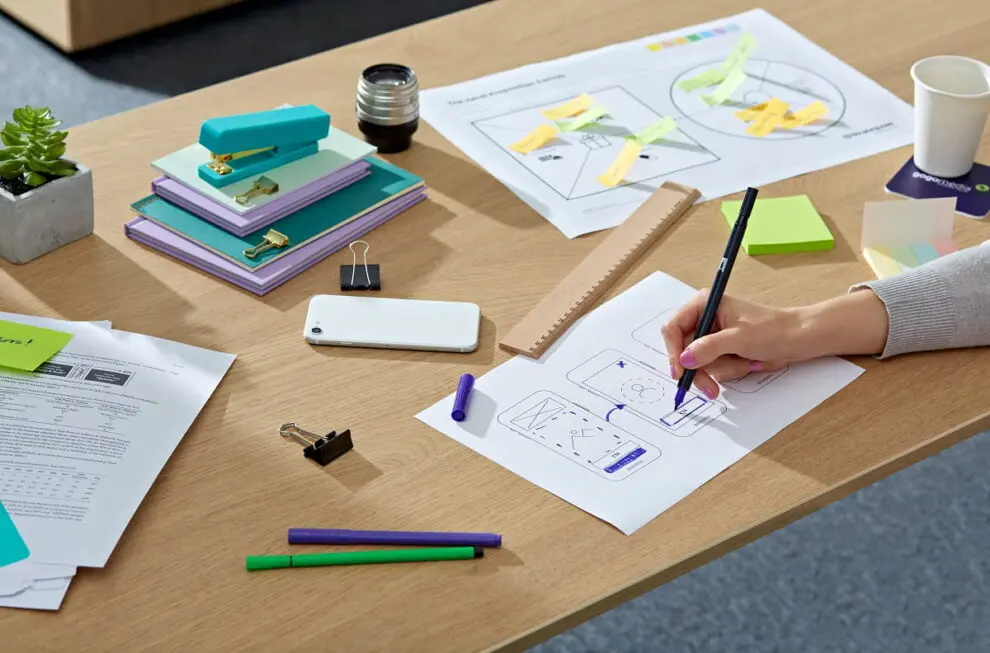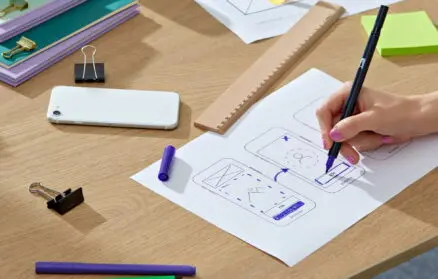
How to conduct user research in UX?
Czas czytania:
As designers of an application or site, we want to make it as easy to use as possible, and we want the user to easily get to the information they are looking for. It is not enough to rely on one’s own knowledge and intuition. It is important to conduct a comprehensive user study. What do they consist of?
What is user research in UX?
There is no better way to test the performance of a product than to observe how real people use the functionality. This is what user research is all about. It’s observing how a user completes a task – registers in an app, buys an item in an online store, finds information on a website, etc.
If we forgo testing, we must rely solely on our own judgment and predictions. As product developers, we know the product very well, we know how it works. In doing so, we are not objective, as we have a vested interest in its market success. Some problems we may not notice, and others we may downplay and ignore.
Users testing the product can catch errors and imperfections. They take a fresh look at our design, help identify areas for improvement, or suggest a new solution (such as adding a button).
Main division of usability tests
moderated – in-person and remote
We accompany the respondent during moderated usability tests. We can ask him questions and answer his questions. This way we get a lot of information from the user. We will see what concerns he has and where in the application there may be problems.
We can conduct moderated tests in the office (so-called laboratory tests). We then have direct contact with the respondent. We can create a space where nothing will distract him and no third parties will appear.
You can also moderate tests remotely, such as by phone. The user then works on his own equipment and in an environment he knows well. This makes him feel at ease and relaxed.
unmoderated
Unmoderated tests are much cheaper and more convenient for the company. It is enough to provide users with a mock-up of the product, which they test most often in their own homes, without our presence. Testing can be done on a larger scale and faster. We will also catch behavioral patterns this way.
However, the lack of interaction with the researcher means that questions can be unclear to users. Their answers are also sometimes quite superficial, and we do not have the opportunity to elaborate on the answer. Even remotely monitoring and recording subjects’ activities without contacting the facilitator may not provide all the information.
exploratory, evaluative and comparative
Exploratory testing involves brainstorming with a group of testers. It allows them to independently express opinions, diagnose problems and propose solutions. The method makes it possible to observe spontaneous reactions and generate new ideas, driven by the creative energy of the group.
Evaluation studies focus on user satisfaction while using the product. They give us a chance to evaluate our solutions. The user selects one of the proposed solutions during testing. Tests can be conducted in person or remotely. Comparison tests involve presenting testers with two different solutions. By checking the performance of the functionalities, they decide which one is more convenient to use.
UX user research – sample methods
Partisan research
They rely on random selection of participants. They can be carried out, for example, by asking people encountered in a public space like a shopping mall to test the design. In this way, we will find out whether our mockup is understandable by personally collecting feedback from the respondents. It’s important to remember that we will have no more than 5-10 minutes for each test, as that’s how much the testers caught on the run will probably want to give us.
This method can be good for startups that cannot afford, for example, moderated on-site surveys. Its primary downside is that users are not selected in terms of target audience. So if we are developing a more niche product, they don’t make much sense, because they won’t give us reliable answers to questions about the usability of the project.
Personal laboratory tests
These types of tests are conducted one-on-one – the test subject and the moderator. The respondent performs the tasks, while the facilitator observes him and asks questions. If you are performing tests in a professional laboratory, there may also be other observers of the experiment behind the Venetian mirror.
Advantages of this type of research include. controlled conditions under which they take place. They are identical for each testee, making it possible to conduct more reliable comparative analyses. Unfortunately, personal laboratory tests are expensive and take time. It is not easy to survey a larger group of people in this way, which makes it difficult to determine whether we will analyze our target reliably.
Non-moderated remote testing
Unmoderated remote testing can give us access to a large group of users. Besides, they are cheap. We recruit respondents using Facebook, for example. Often it is not necessary to offer them a material benefit in exchange for their help – users may want to take the test out of simple curiosity.
Respondents solve tasks on their own devices and in their environment. The large sample size makes it possible to observe user behavior patterns. However, we do not have insight into their reasoning, so it is best to conduct tests as a supplement to individual research. Remotely and without moderation, we will test, for example, hypotheses put forward in other studies.
As part of unmoderated remote testing, in addition to simple surveys, we can use the following methods to examine user behavior:
- Session recordings: we will see how the user behaves, check which elements of the interface are most interesting to him and which ones give him trouble. We can use heat maps for this purpose using tools such as HotJar.
- Online testing tools and platforms (e.g. UsabilityHub): using them, we have the chance to record users’ actions, including audio and video recordings of their reactions, facial expressions or gestures. It also uses rapid effective tests that work well in mass actions.
These include. 5-second test. In it, users are supposed to state after such a time, for example, what element caught their attention or answer the question of who they think the product is aimed at.
First-click tests are also used. There, users are given a task to perform (such as making a purchase) and it is recorded whether they know how to start the action (i.e., simply where to click first).
Phone tests
This type of testing involves instructing the user over the phone what task they should perform. He stays in his own environment, working on his device, which may have some advantages over working on our premises (more natural behavior). Its activity is recorded, and the remote presence of the moderator means that user research can be shaped in a flexible way.
eye-tracking
Eye-tracking involves tracking eye movements, pupil dilation and the points at which the user looks. This allows us to find out what the respondents focus on, what elements are important to them, and which are ignored. We will also find out, for example, what in our product triggers their excitement (pupil dilation).
Eye-tracking uses eye-tracking cameras, special glasses or devices installed opposite the tester.
Always check usability
We can tailor the type of research conducted to suit your budget. If you’re running a start-up and don’t have a lot of resources, you can opt for simple guerrilla testing, invite a few people you know into the company to let them “click through” the product, or use the usually not very expensive online testing tools.
Being able to allocate a higher budget for user research, we will in turn test larger numbers of users. We will also be able to offer them some kind of benefit for taking part in the tests, making it easier to recruit people. We will also hire an appropriate number of moderators, and conduct various types of tests.
Either way, we need to find time and resources for usability testing. Otherwise, we will only find out if the product has hit users’ tastes once it is available on the market. It may then turn out that it needs fundamental changes or customers don’t need it at all, and we will lose the money spent on development and marketing.
We also recommend you: UX writing – how to write for a better user experience

Zainteresował Cię ten artykuł?
Może Cię również zainteresować:
5 things to look out for when choosing a dedicated ERP, WMS or LMS system
Creating dedicated web applications (accessible via a web browser from a computer, tablet or phone)… Read More
Discovery workshops – 5 reasons why you should do them
The post comes directly from our official social media channels. In the… Read More
Optimizing eCommerce vs. External Technology Director
🛠️ Case study 🛠️The post comes directly from our official social media… Read More


